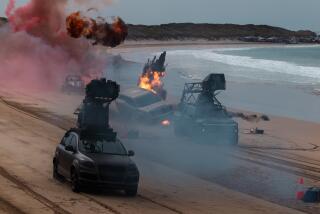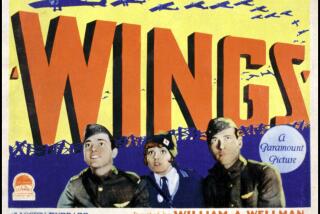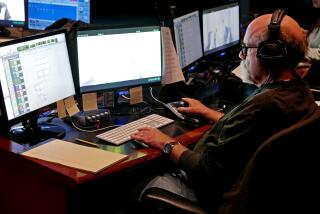John Stears; Special Effects Genius Behind 007 and R2-D2
- Share via
John Stears, the dean of motion picture special effects and a two-time Academy Award winner who created such memorable icons as the R2-D2 robot of “Star Wars,” James Bond’s deadly 1960s era Aston Martin and the flying car of “Chitty Chitty Bang Bang,” has died. He was 64.
Stears died April 28 in UCLA Medical Center after a stroke, said Eric Simmel on Sunday. Simmel, a close family friend, said Stears’ wife, Brenda, and other family members had wanted the death kept quiet until after services in Pacific Palisades in May and in London last week. Stears, a Briton, maintained homes in Pacific Palisades and in Beaconsfield, England, where he and his wife raised cattle and show dogs.
The special effects wizard for the first eight Bond films earned his first Oscar--solo--in 1965 for “Thunderball,” which starred Sean Connery and featured an underwater battle scene.
Stears’ second Oscar, for “Star Wars” in 1977, was shared, as the genre began calling for larger staffs.
But it was Stears who held the patent on lovable rotund beeping little R2-D2, the droid who has now been a mainstay in four of the George Lucas “Star Wars” films. It was also Stears who, along with John Dykstra, was credited with the original film’s climactic aerial dogfight, prompting one enthusiastic reviewer to write in 1977: “No honor under the sun is sufficient to recognize the contribution of people like John Dykstra and John Stears. . . .”
In addition to R2-D2, Stears created Lucas’ Death Star, young Luke Skywalker’s hover-car land speeder and the indelible light sabers, and he helped with his droid’s sidekick, the equally lovable and metallic C-3PO.
For Bond, Stears blew up the villain’s lair in the first film, the 1962 “Dr. No.” Two years later, for “Goldfinger,” he created the Aston Martin DB5 with bulletproof windows, machine guns, a rear oil-slick dispenser and Stears’ personal favorite, a passenger ejection seat.
When Pierce Brosnan, the Bond for the late 1990s, got into a BMW a few years ago, the British Stears railed in the London Daily Telegraph: “James Bond in a BMW? I think it’s the pits. He’s supposed to be a member of Her Majesty’s Secret Service. He would only ever drive a British car.”
Stears added that the newer model Aston DB7 “would have been perfect for Bond” and that he would personally have welcomed the chance to adapt it: “I’d love to do a new James Bond car. Just think of all the amazing space-age devices you could build into it; armour-piercing lasers, global positioning and all that stealth technology. No one would ever catch him.”
Ironically, although he had doubts about making the ejector seat work--a concern that proved unfounded--Stears designed one feature of the original Bond car that was never used. He gave the car the ability to fire three-pronged nails from under its taillights that could pierce an enemy’s tires. But British authorities asked that the device be deleted from any film out of fear real-life criminals would copy it.
The term “F/X” which is movie shorthand for “special effects” became the title of one Stears film that somewhat imitated his own life. The 1986 film which became a sleeper hit and spawned a sequel and a television series featured an F/X hero hired to fake an assassination for the Justice Department.
“I have been approached three times by various (government) agencies to do similar sorts of things as we are doing here,” Stears told The Times in 1985 while filming the movie in New York. “I can’t really talk about it at any length, because these have all been official government concerns. But I can say I’m glad I didn’t get involved. . . .”
Extensive critical acclaim for the film never failed to cite Stears’ work on the accurate and excellent special effects. The Times’ review of “F/X” in 1986 said Stears’ work helped make the film “float above the crowd” of current movies.
After he made the Bond’s Aston Martin, Stears created Dick Van Dyke’s whimsical flying car for the 1968 “Chitty Chitty Bang Bang,” which like the Bond films was based on an Ian Fleming novel.
When the film was re-released on its 30th anniversary last year, Stears told an interviewer that building the car posed problems because it had to start out as an old racing car and then become a magic flying car. “It was a great car to build. A lot of fun,” he said, noting that without computer-generated special effects in 1968, he had to use “the old techniques, had to do things the hard way.”
Born in Uxbridge, England, Stears attended Harrow College of Art and Southall Technical College and served in the British Air Ministry as a draftsman. He began his career by making scale models of buildings designed by an architects’ firm.
He was first commissioned by the film industry to build model aircraft for the 1956 “Reach for the Sky” about a British pilot who lost his legs but continued to fly.
Stears then went to work for the Rank Organization, where he built model boats and planes for such films as “The One That Got Away” in 1957 and “A Night to Remember” in 1958.
Then came the Bond films and recognition for Stears as a leader in the evolving special effects field. He built the flying carpet for the 1978 version of “The Thief of Baghdad” and created special effects for such 1980s films as “The Awakening,” “Outland,” “Miracles,” “The Bounty” and “Haunted Honeymoon.”
His most recent motion picture, in which he was credited as special effects coordinator, was last year’s “The Mask of Zorro.”
Stears did occasional work for television, including the miniseries based on Ray Bradbury’s “The Martian Chronicles” in 1980 and “Babylon 5: The Gathering” in 1993.
Survivors include his wife; two daughters, Jacqueline and Janet; and three brothers, Peter and David of England, and Andrew of Sao Paulo, Brazil.
More to Read
Only good movies
Get the Indie Focus newsletter, Mark Olsen's weekly guide to the world of cinema.
You may occasionally receive promotional content from the Los Angeles Times.










